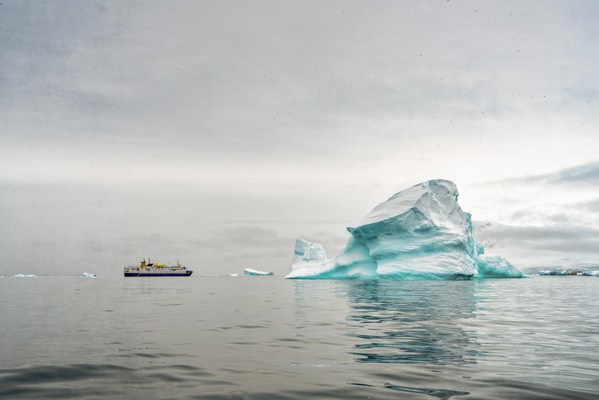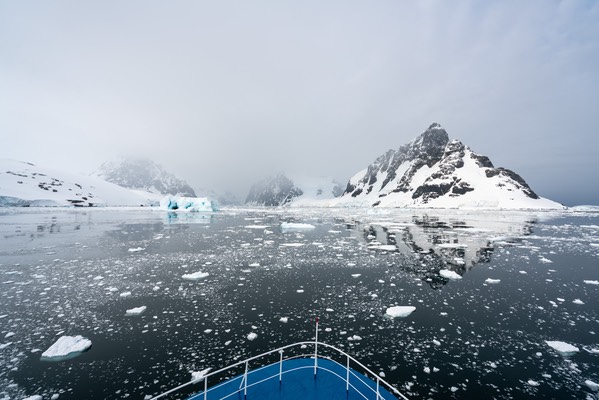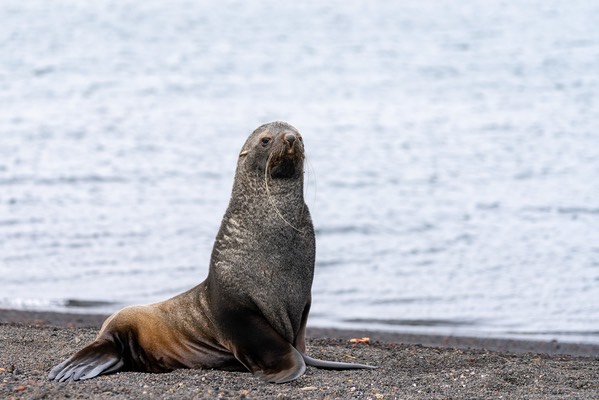This is a subsection of our larger blog “OutsideGo-Awasi Patagonia-Antarctica 21” that comments specifically on the Antarctica portion of our trip. If you just want to see our pictures from Antarctica, click here.
Visiting Antarctica has always been on my bucket list and my 7th continent. It is not top of the list to escape the long, cold Chicago winters, but rumors suggested a visit would be a remarkable experience. We had received an email from OutsideGo about Antarctica 21 and given this was on my bucket list, we began exploring the possibility. We always pay attention to OutsideGo emails!
General considerations: (5 stars)
There were two very significant reasons to visit Antarctica through Antarctica 21. Instead of sailing the Drake Passage (a 2 day trip), we would fly from Punta Arenas to Teniente R. Marsh Airport at Frei Station on King George Island. This saved two days of travel and avoided the potentially very rough Drake Passage trip. The second reason was the small size of the tour group (maximum 71). This allowed everyone to leave the boat (Ocean Nova for us) at each activity, multiple times daily.
They also offered kayak and snowshoe outings. We did not participate in those activities, but the individuals who did really enjoyed them.
Pre-tour communications and arrangements: (5 stars)
Once we decided to use Antarctica 21, we received a web link that provided a tremendous amount of information in the form of videos and pdf files including clothing requirements, sunglasses recommendations, accessories, guidelines for zodiac and land visits, contingency plans (weather can cause delays), photography tips, access to the internet and many other useful things.
When we arrived at Hotel Cabo de Hornos, we had our boot fitting (heavy rubber boots for wet landings), a detailed orientation of the trip and then a pleasant cocktail hour and dinner with the people going on the trip with us.
Cocktail hour at Hotel José Nogueira the night before departure to Antarctica
It is very important that your boots fit correctly as walking on the snowy continent can be challenging, otherwise.
This is perhaps the best pre-tour communication we have ever experienced.
Communications during the tour: (5 stars)
There were two to three briefings a day between the two daily outings and meals. These briefings included plans for the next day, recaps of the day’s activity and a number of presentations about Antarctia that greatly enriched the experience, such as knowledgeable discussion of the role of phytoplankton in the life cycle in the Antarctica, the origin of Antarctica as a continent, or thoughts and data on current global warming issues. There were also public announcements of activities planned or beginning.
The expedition guides and crew were very knowledgeable, worked hard to insure the safety of the passengers and to educate us about Antarctica. Several of them stand out: Alcibíades Ulises Barrios Herrera, Captain; Karen Parada, Cruise Manager; Hadleigh Measham, Expedition Leader; André Belem, Education and Science Coordinator; Ashley Cooper, Expedition Guide-Photographer; Rodrigo Moraga, Marine Biologist-Photographer; Allison Lee, Polar Specialist-Oceanographer; Jamie Watts, Expedition Leader-Marine Ecologist. All the other guides/crew were equally outstanding. Captain Herrera safely guided our ship through iceberg filled waters and did an incredible job in the Icebird rescue. Both Ashley Cooper and Rodrigo Moraga gave the whole cruise some of their spectacular images, including breaching whales and Ashley gave a wonderful pictorial presentation on the consequences of global warming. Hadleigh Measham did an excellent job communicating ever changing plans for the day, pleasant wakeup music and messages and selecting the best possible sites for us to disembark from the Ocean Nova. Finally, Allison Lee led several fascinating discussions on phytoplankton and her citizen science project sampling phytoplankton. André Belem lead the education and science team that provided a variety of wonderful discussions that greatly enriched the Antarctica 21 experience. We have remained in contact with André via email and he has been extremely helpful refreshing my memory of different parts of the cruise. For this we are deeply grateful.
Accommodations: (It’s an icebreaker ship cabin!)
We have not provided any stars for this category. Our cabin had a small desk, two beds, a bathroom/shower of about 10-12 square feet with a very tiny shower and a small closet. The total cabin was about 100 square feet with a number of hooks to hang clothes. Over the desk were several electrical
Ocean Nova Sleeping quarters
outlets (standard European round two pin plugs) and USB charging outlets. We adapted to the space quite well, but we have not rated it as we have no basis of comparison. Given that we were on a boat, we suspect these were pretty good accommodations. There was also a physician onboard that proved very useful: gave us some great sea sickness medicine (dramamine was insufficient) and counseled/reassured me on a nasty pulled hamstring.
What was seen/experienced: (5 stars)
It is important to appreciate the fact that this experience is highly planned and yet unplanned. As we set out, the expedition manager, Hadleigh, enlightened us by telling us about the highly variable weather and how they would try to find interesting places to visit that had reasonably acceptable weather conditions. At the end of the day, there was a rough sketch (or to be determined-TBD) as to where we might visit the next day, but that depended on how the weather was the following morning. When we arose for breakfast and morning briefing, we knew more or less what we would be experiencing that day.
This planned/unplanned character was highlighted our first evening, before departure, in Punta Arenas. If and when we would depart to King George Island was announced during our pre-departure dinner, roughly 12 hours prior to our actual departure. We had to be fully dressed for Antarctica prior to boarding the plane, including our Antarctica boots and water proof pants. This made for a toasty ride to airport, but once on the plane, heavy coats were removed. This seemed a bit crazy as we were from Chicago and quite used to blustery winter weather.
The flight from Punta Arenas to Frei Station was about 2 hours. Our approach was heavily overcast, but we could see some land and ‘rocks’ in the water. Upon exiting the plane, we were greeted with a blizzard, horizontal snow and biting cold. We knew we had a 40 minute walk, single file on a muddy, puddle filled make shift road to the zodiac boarding location. First impression: ‘Oh my god, how bad is this going to be’ and ‘how strikingly barren the landscape really is’.
In front of our plane. Smiling, but see those white streaks, giant snow flakes at 1/320 of a second, they were moving that fast. Very cold.
First impression of Antarctica: a god forsaken place
We were given a life jacket at the zodiac landing (we kept this for the rest of the trip) and refreshed on how to get into the zodiac. In all of the training videos, the zodiac was calmly resting on the shore. Not now. The zodiac bounced and lurched from wave action and made entry considerably more challenging than anticipated. The ride to Ocean Nova and transition from the zodiac to the boat was a rolling adventure. The seaman grip proved to be very useful!
Once on board, we explored a bit and settled into our room. Once everyone was on board, we had our first briefing in the Observation Lounge and set sail from Frei Station out of Maxwell Bay into Bansfield Strait. We passed a large tabular iceberg, A57A (12.7 by 5.8 miles in size), and many ‘smaller’ ones as
A ‘small' iceberg in front of A57A. The bright mid portion of the sky is caused by light reflected off of A57A.
we had a training drill for using the two life boats. The sheer beauty rapidly changed our first impression. Sea sickness set in as we went further out into the Bansfield Strait, effectively treated with Marezine from the onboard physician. To see all of Day 0-2 pictures, click here.
Sometime overnight, we entered the Gerlache Strait, the waters calmed and we were joined by a family of Humpback Whales. They swam with us for quite a while, affording an opportunity to get some nice photographs. Our
Humpback Whale in Gerlache Strait, Antarctica
first zodiac excursion was at Portal Point, a true Antarctica continent landing. The rocks were slippery with a steep drop off. The sailor grip and our walking sticks were very helpful on this landing. We climbed up a hill along a
Hiking back to Portal Point with zodiacs waiting to return us to the ship
A matter of perspective: Ocean Nova vs. iceberg on our way back to the ship
red flag marked path to experience a snow filled view. It was important not to stray from the path, as one or two steps off the path could result in sinking to your hips in snow!
As we headed further into the Gerlache Stait toward Useful Island, we were joined by a pod of Orca Whales. We were able to get some nice pictures from

Orca Whales in Gerlache Strait
the observation deck, but it was very cold. Two layers on the bottom, 5 layers on top, a Columbia Titanium Omni Heat Hat with hood and two layers of glove was sufficient. The inner fleece glove worked well with the camera and kept the hands warm enough for a short period of time.
Useful Island: Gentoo Penguins were everywhere at the lower level and Chinstrap were higher up. We were very lucky to see young penguins as they typically bred earlier, but in the case of first chic loss, they will lay more eggs.
Gentoo Penguins with young chicks on Useful Island
Both parents care for the young and feed by regurgitating food into their beak while the chick gathers the food by inserting their head into the parent’s mouth. The other quite remarkable experience is the overwhelming pungent odor that can be smelled a distance away and adhers to your clothing on return to the ship. To see all the pictures from Day 2, click here.
Lemaire Channel: The decision was taken the evening before to try to make passage through the Lemaire Channel. This attempt was going to be the first for the season by any Antarctica cruise. The channel is ice filled, approximately 7 miles long and only a half mile wide at the narrowest point.
Icy and narrow entrance of Lemaire Channel
The waters are very still, reflecting the mountains and glaciers on the side for incredible sites. Our zodiac trip in the morning was to cruise through the icebergs, photographing seals, penguins and birds. Weddell, Leopard and
Crabeater Seal in Lemaire Channel
Crabeater seals were seen. At one point, we hopped out of the zodiac onto a 50 foot around flat (pancake) iceberg. While we were taking pictures on the iceberg, a few penguins jumped on, quite surprised we were there and quickly jumped back off.
As we enjoyed the icebergs and seals, the bridge received a state of urgency call (pan-pan) from a small 61 foot yacht, Icebird, requesting assistance. Our boat captain agreed to come to their aid. Our initial thought was to wonder why such a small boat would be in these perilous waters, but Icebird is specifically designed to operate in these conditions and the crew is highly experienced. They suffered a most unfortunate motor failure. We arrived,
Icebird trapped in ice field after motor failure
place a tow line, and then pulled them through considerable ice to the Vernadsky Station, a Ukrainian research base. The station was to send zodiacs out to the boat, bring the crew on shore, so they could use the machine shop to effect repairs on the motor. That was a solid plan with the exception that the ice was so thick, the Ukrainian zodiacs could not make it to the Icebird. We reattached Icebird and proceeded to tow it back through Lemaire Channel to Base President Gabriel González Videla (Chile). To see all of our pictures from Day 3, click here.
Neko Harbour: This was our second continental landing. The harbour was discovered by Adrien de Gerlache during his Belgian Antarctic expedition (1897-99). It is named after the Norwegian whaling ship, Neko, which often used this bay. A prominent feature is a large glacier which sometimes can be seen calving that caused very substantial waves at the landing beach. Because of this we were warned to not stay near the beach area. We heard, but did not see, some calving. The large glacier and the approximate 250 breeding pairs of Gentoo penguins made for some great photography.
Gentoo Penguins at Neko Harbour
Whilhelmina Bay: Our second zodiac excursion on this day was to join, up close and personal, a group of Humpback Whales. We saw many tail flips and a few actually had whales come up by the zodiac! The water level
Humpback Whale in Wilhelmina Bay
Humpback Whale in Wilhelmina Bay
perspective of whale tails flipping out of the water with glaciers and snow-covered mountains in the background etched a permanent memory as to how vibrant, magnificent, and yet isolated Antarctica truly is. To see all of our pictures from Day 4, click here.
On our next to last day, we visited Deception Island, landing at Whalers Bay and Half Moon Island. Deception Island is an active volcano, last erupting in 1969. The caldera is filled with sea water to form Port Foster. The entrance is called Neptune Bellows, a narrow, 755 foot wide passage into the sea filled caldera, and just past this point is Whalers Bay. The Whalers Bay community was established in the early 19th century to serve the whale oil industry, where the blubber was converted primarily to whale oil for lamp burning. Large rusty tanks that held processed whale oil still stand, highlighting how
Whaler Bay and whale oil storage tanks in disrepair
aggressively whales were hunted in Antarctica in the earlier part of the 19th century. Kerosene eventually displaced whale oil and international protections in 1966 prevented the hunting of whales. These have helped stabilize and encouraged recovery of the whale population. We also saw a wonderful example of a Fur Seal.
Fur Seal at Whalers Bay
Our last stop was Half Moon Island, a beautiful island with lots of wild life, in particular Chinstrap penguins. The general rule is to not get closer than 15 feet, but the Chinstraps did not know this rule and would frequently waddle
Chinstrap Penguins on Half Moon Island walking right past us
within a few feet of us standing perfectly still. This created some great opportunities for very close photographs. There is a photogenic wrecked whaling boat on the beach. To see all the pictures from Day 5, click here.
Wrecked whaler boat on Half Moon Island
We returned to Frei Station overnight where we could get an Antarctica immigration stamp for our passports. Once everyone had disembarked the Ocean Nova we hiked back to the landing field and waited for our flight back to Punta Arenas.
Leaving Antarctica from Frei Station
With this description and accompanying pictures, we hope the 5 star rating is understandable. Antarctica is extraordinarily beautiful and sharply different than anywhere else in the world. The magnitude of the sheer raw forces of nature are difficult to explain. To see all the pictures from our last day in Antarctica, click here.
Food: (5 star)
The good food on Ocean Nova greatly exceeded my expectations. The breakfast and lunch were buffets with diversity of choice and always something good to eat. For dinner, salads/cheese/crackers were buffet, but the dinner was ordered off a menu and served to you. A variety of beverages, including wine/beer, were available. The dinner meal was consistently good quality and again exceed our expectations.
Example of Ocean Nova Menu




















